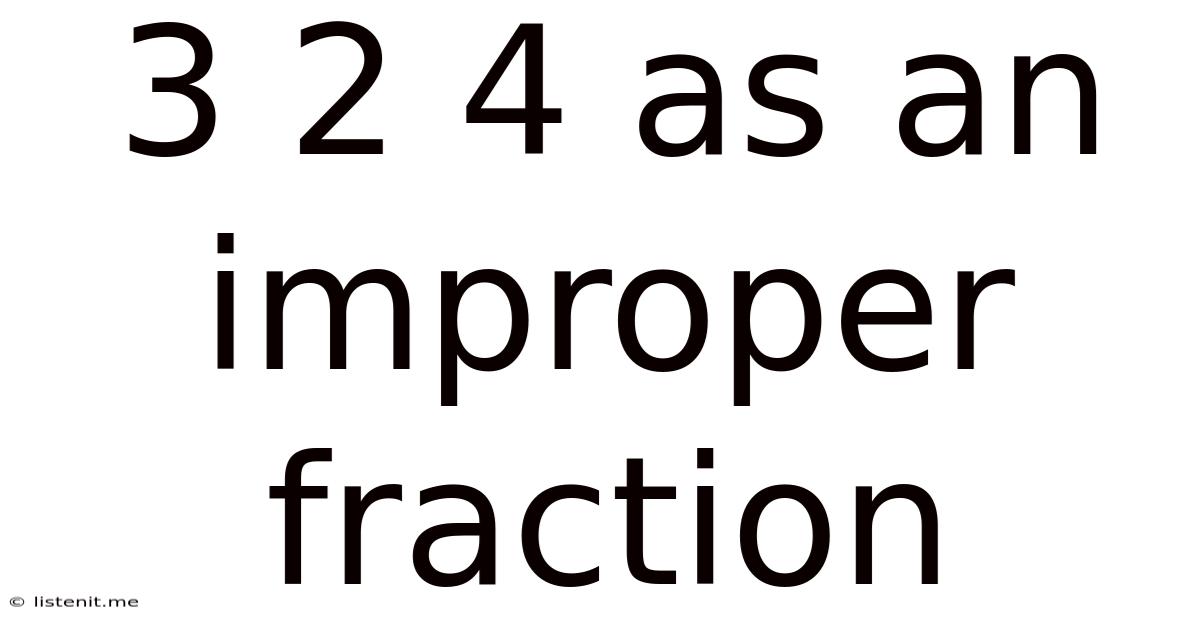3 2 4 As An Improper Fraction
listenit
May 23, 2025 · 4 min read

Table of Contents
3 2/4 as an Improper Fraction: A Comprehensive Guide
Understanding fractions, especially converting between mixed numbers and improper fractions, is a fundamental skill in mathematics. This comprehensive guide will delve into the process of converting the mixed number 3 2/4 into an improper fraction, explaining the underlying concepts and providing examples to solidify your understanding. We'll also explore the broader context of fractions and their applications.
What is a Mixed Number?
A mixed number combines a whole number and a proper fraction. A proper fraction has a numerator (the top number) smaller than the denominator (the bottom number). In our case, 3 2/4 is a mixed number: 3 is the whole number, and 2/4 is the proper fraction.
What is an Improper Fraction?
An improper fraction has a numerator that is greater than or equal to its denominator. This indicates a value greater than or equal to one. Converting mixed numbers to improper fractions is a crucial step in many mathematical operations, particularly when adding, subtracting, multiplying, and dividing fractions.
Converting 3 2/4 to an Improper Fraction: Step-by-Step
The conversion process involves two simple steps:
-
Multiply the whole number by the denominator: In 3 2/4, we multiply 3 (the whole number) by 4 (the denominator). This gives us 12.
-
Add the numerator: Next, we add the numerator (2) to the result from step 1 (12). 12 + 2 = 14.
-
Keep the same denominator: The denominator remains unchanged. It stays as 4.
Therefore, 3 2/4 as an improper fraction is 14/4.
Simplifying Improper Fractions
Often, improper fractions can be simplified to their lowest terms. This means reducing the fraction to its simplest form by dividing both the numerator and the denominator by their greatest common divisor (GCD).
In the case of 14/4, the GCD of 14 and 4 is 2. Dividing both the numerator and denominator by 2, we get:
14 ÷ 2 = 7 4 ÷ 2 = 2
So, the simplified improper fraction is 7/2.
Visualizing the Conversion
Imagine you have three whole pizzas and half of another pizza. This can be represented as 3 2/4 or 3 1/2 (since 2/4 simplifies to 1/2). To express this as an improper fraction, think of cutting all the pizzas into fourths. You would then have 12 fourths (3 pizzas x 4 fourths/pizza) plus 2 more fourths, resulting in a total of 14 fourths, or 14/4. This visually demonstrates the equivalence of the mixed number and the improper fraction.
Practical Applications of Improper Fractions
Improper fractions are essential in various mathematical contexts and real-world scenarios:
-
Adding and Subtracting Fractions: It's easier to add or subtract fractions when they are expressed as improper fractions with a common denominator.
-
Division of Fractions: Converting to improper fractions simplifies the process of dividing fractions.
-
Measurement and Calculations: In construction, cooking, and other fields, using improper fractions streamlines calculations involving parts of whole units.
-
Algebra: Solving algebraic equations often requires working with improper fractions.
Further Exploration of Fractions
This section expands on the fundamentals of fractions, providing a more comprehensive understanding of their properties and operations.
Types of Fractions:
- Proper Fractions: Numerator < Denominator (e.g., 1/2, 3/4)
- Improper Fractions: Numerator ≥ Denominator (e.g., 7/2, 5/5)
- Mixed Numbers: Combination of a whole number and a proper fraction (e.g., 3 1/2, 2 3/4)
- Equivalent Fractions: Fractions representing the same value (e.g., 1/2 = 2/4 = 3/6)
Operations with Fractions:
-
Addition and Subtraction: Requires a common denominator. Add or subtract the numerators, keeping the same denominator.
-
Multiplication: Multiply the numerators together and the denominators together. Simplify the resulting fraction if possible.
-
Division: Invert the second fraction (reciprocal) and multiply.
Simplifying Fractions:
Find the greatest common divisor (GCD) of the numerator and denominator and divide both by the GCD. This reduces the fraction to its simplest form.
Error Prevention and Troubleshooting
When converting mixed numbers to improper fractions, common mistakes include:
-
Forgetting to add the numerator: Ensure you add the numerator to the product of the whole number and denominator.
-
Incorrectly calculating the GCD: Double-check your calculation of the greatest common divisor for simplification.
-
Using the wrong denominator: The denominator remains unchanged during the conversion process.
Conclusion
Converting 3 2/4 to an improper fraction is a fundamental arithmetic skill with broad applications. Understanding the steps involved – multiplying the whole number by the denominator, adding the numerator, and keeping the same denominator – is crucial. Remember to always simplify the improper fraction to its lowest terms. This guide provided a clear step-by-step approach, practical examples, and a broader exploration of fractions to ensure a thorough understanding of this essential mathematical concept. By mastering this skill, you build a strong foundation for more advanced mathematical operations and problem-solving. Continuous practice and application are key to solidifying your understanding and increasing proficiency with fractions. The ability to confidently convert between mixed numbers and improper fractions is an essential component of mathematical fluency.
Latest Posts
Latest Posts
-
2 1 5 As An Improper Fraction
May 23, 2025
-
What Is 1 4 Of 60
May 23, 2025
-
How Many Hours Are In 7 Years
May 23, 2025
-
2 5 X 2 5 X 2 5
May 23, 2025
-
3 5 To The Power Of 2
May 23, 2025
Related Post
Thank you for visiting our website which covers about 3 2 4 As An Improper Fraction . We hope the information provided has been useful to you. Feel free to contact us if you have any questions or need further assistance. See you next time and don't miss to bookmark.